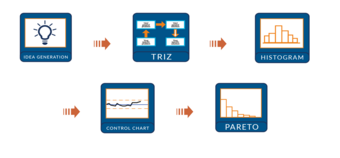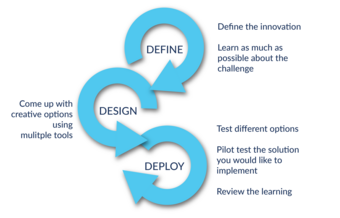
Innovation – What does it look like in quality environments?
Progress indicator
Sponsored article: This article looks at how quality methods can provide the structure and environment required to stimulate and develop innovation in business, to better serve customers and stakeholders.
By: Susannah Clarke, Managing Partner and Head of Skills & Capability Practice at PMI
Innovation is on the agenda for every organisation looking to grow. But innovation takes many forms and some organisations find themselves victims of innovating in ways that are not productive or achieving the radical innovation that they need, or are too costly.
What sort of innovations do businesses experience?
Businesses experience innovations in three broad areas.
First, evolutionary innovation or ideas. These are often extensions of products and services a business already delivers – the innovation is a new presentation of it. Kellogg’s is a great example of this; think Corn Flakes (the original and best), Crunchy Nut Corn Flakes (sweeter and nuttier), Special K (the less than 2% fat, health-conscious cornflake), the Corn Flakes Crumb to coat your meat/fish/chicken/vegetables. The list goes on but you get my drift. The point is Kellogg’s was not satisfied with the success of its original cornflake, so the company took steps to evolve it, to gain more customers and compete with its rivals. Have you been innovative in extending the products and services you deliver to internal and external customers?
This evolutionary innovation needs an environment where ideas can be generated. How might you create the space for such creative work?
The second category we could call ‘opportunistic’ innovation. Have you read about the osteoporosis drug which also cures baldness? Did you know that Botox, which hit the market in 2002 as a wrinkle remover, came from research into treating crossed eyes, twitching/muscle spasms? Through the drug testing phases, a new application of the drug was discovered and this created a new market opportunity. Have you been involved in developing opportunities through your products, services or processes? Perhaps transferring methods or ideas from one part of your business to another?
Opportunistic innovation needs an environment where these opportunities can be spotted, so that the discovery can become a new product/service.
The third innovation is ‘breakthrough’ innovation – the development of new ideas for product or service development, or the radical redesign of processes resulting in a step change in performance.
Creating the environment where innovation is possible in a way that is sustainable and the cost, time and energy involved are commensurate with enabling the company to survive whilst the innovation that takes place can be very challenging. The product or service must be designed such that when brought to market it achieves the right level of quality and is commercially viable. Remember the days when it took more than a week to receive goods ordered? Through the radical redesign of delivery services, Amazon Prime and thousands of online shops can now deliver your goods the same or next day, and if you're a subscriber, at no extra cost.
Breakthrough innovation will only happen in an environment which is designed for this purpose. Have you been involved in such a project or development?

Innovation through quality methods
Innovation can and does happen in unpredictable or chaotic environments in which people are regularly firefighting, jumping to solutions without testing, risking failing to supply to customers and where processes are not in control, stable or predictable. However, systemic innovation requires focus, structure and tools to help teams develop their ideas. This is where quality methods can help create the right environment for the innovation and quality tools to help deliver innovation.
Let’s look at four simple stages to show how this can work.
Stage 1: Where are we now?
Understand where you are today. Innovation is more likely to happen and be noticed in an environment where:
- there are quality methods in place to measure performance;
- your processes are in control so you can identify a change in performance;
- you can attribute a change correctly, good or bad;
- you have data and analysis to inform decisions.
In this stage, use quality tools such as Pareto charts, control charts or flowcharts to help gather useful data to understand the process, understand your customers, your competitors, market trends and any other data that will support the business case for the work. This information will help you support the context of the innovation and provide useful insights to help define the overall goal for the innovation.
Stage 2: Where are we going?
Agree which type of innovation you are working on for each project: evolution, opportunistic or breakthrough. Breakdown the overall goal for the innovation into practical objectives. This will help focus the innovation.
Stage 3: How are we going to get there?
Having established what you are aiming for (step 2), you are now in a great position to select the appropriate method(s) for innovation.
Evolution: Think about using a quality improvement methodology such as Structured Problem Solving or Lean Six Sigma to provide the overall structure. Creative thinking methods work well here. If you are looking to extend an existing product range or service, quality methods such as TRIZ (a problem-solving, analysis and forecasting tool), structured idea generation, or Lateral Thinking are all great methods for evolving existing scenarios.
Opportunistic: Create an environment and a culture in which you can notice a change, where you ‘learn to see’ what is happening in your system. Quality tools such as Pareto diagrams, control charts, histograms and stratification will aid you in noticing an opportunity and/or change. Continuous improvement methods will help you gather other opportunities that can be taken further to innovate products, services or processes.

Breakthrough: By its very nature it’s the big investment, it requires a dedicated programme and a consistent quality method such as Design for Six Sigma, founded on PDSA (Plan, Do, Study, Act), with goals, roles and responsibilities clearly articulated and agreed. Align the work to your organisation’s strategy – your chances of success are increased when you have leadership commitment.
And, as in all forms of innovation, you must be prepared to take risks and fail.
These are not concepts which are typically embraced by organisations, but remember it took James Dyson 5,127 attempts to create the bagless vacuum cleaner and Thomas Edison 50,000 experiments to develop the battery!
Stage 4: How are we going to make it stick?
Innovation is only part of the equation, on its own it’s no more than a great idea. Bring your creativity to life in a sustainable way through a robust implementation process. Quality methods such as Lean Six Sigma have implementation built into the method. In other situations, planning implementation and integrating into daily process management are required.
About the author:
Susannah Clarke is Managing Partner at Process Management International (PMI), Head of Skills & Capabilities Practice and a specialist in the field of Executive and Performance Coaching. Susannah has worked extensively in the learning and development sector, starting her career with NatWest Markets in the City before spending 17 years with GSK as a consultant.
In 2011 Susannah joined Oracle University as Partner Director for Europe, the Middle East and Africa, and in 2013 she joined PMI. As co-author of Implementing ISO9001:2015 she brings together more than 35 years’ experience leading, managing and consulting across different organisations. Susannah has written several blogs and published many articles in leading process and quality focused publications.
Get rewarded for your innovation!
Have you been involved in this kind of innovation? Whether using quality or improvement methods to develop innovative process changes, delight customers or help design an innovative product or service, we would like to hear from you. So why not share it with other quality professionals and give yourself a chance to receive an award for your contribution to the quality profession?
Read more
The latest blogs, opinion, articles and infographics from our PMI bloggers. Learn about business process improvement in action, understand control charts in more detail, get some hints and tips for putting together visual management huddles or change initiatives or just see things from a new perspective!
Quality World

Get the latest news, interviews and features on quality in our industry leading magazine.


